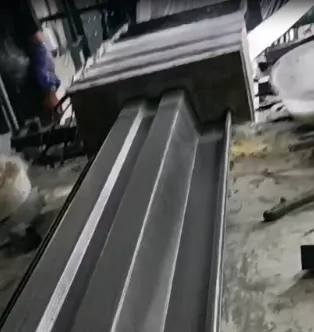loading...
- No. 9, Xingyuan South Street, Dongwaihuan Road, Zaoqiang County, Hengshui, Hebei, China
- admin@zjcomposites.com
- +86 15097380338
- Welcome to visit our website!
Innovative Applications of Glass Fiber Reinforced Polymer Bars in Construction and Engineering
Glass Fiber Reinforced Polymer Bars An Innovative Alternative in Construction
In the rapidly evolving world of construction and materials science, the demand for high-performance, durable, and sustainable building materials has never been greater. One such innovative solution that has garnered significant attention is Glass Fiber Reinforced Polymer (GFRP) bars. These composite materials, which combine glass fibers and polymer resins, are revolutionizing the way engineers and architects approach structural design and construction.
What are GFRP Bars?
GFRP bars are composite materials made of a polymer base that is reinforced with glass fibers. The unique properties of glass fibers, such as high tensile strength, corrosion resistance, and lightweight characteristics, combined with the versatile nature of polymers, result in a material that boasts exceptional performance capabilities. Unlike traditional steel reinforcement bars (rebar), GFRP bars do not corrode when exposed to harsh environments, making them an ideal choice for a wide range of applications, including bridges, tunnels, and marine structures.
Advantages of GFRP Bars
1. Corrosion Resistance One of the most significant advantages of GFRP bars is their resistance to corrosion. In environments where moisture, salts, or chemicals are present, steel reinforcement can deteriorate over time, leading to structural failures. GFRP bars, on the other hand, maintain their integrity even in the most aggressive conditions, greatly extending the lifespan of structures.
2. Lightweight GFRP bars are significantly lighter than steel, which simplifies handling and installation. This property can result in reduced transportation costs and lower labor expenses during construction, ultimately contributing to overall project efficiency.
3. High Strength-to-Weight Ratio Despite their lightweight nature, GFRP bars offer a high strength-to-weight ratio. This feature allows engineers to design lighter structures without compromising on strength and stability, which is particularly beneficial in seismic zones.
4. Electrical Insulation GFRP bars are non-conductive, making them suitable for applications where electrical insulation is crucial. This property prevents the risk of electrical currents passing through the reinforcement material, ensuring safety in sensitive environments.
5. Sustainability As the construction industry becomes increasingly aware of its environmental footprint, GFRP bars present a sustainable alternative to traditional materials. Their durability leads to longer-lasting structures, reducing the need for frequent repairs and replacements. Additionally, the production of GFRP is often less energy-intensive compared to steel manufacturing.
Applications of GFRP Bars
glass fiber reinforced polymer bars

GFRP bars are gaining traction in various applications across the construction industry. Some notable uses include
- Bridges and Overpasses The lightweight nature and corrosion resistance of GFRP bars make them ideal for use in bridges and overpasses, where weight reduction can significantly lower the load on supporting structures
.- Parking Structures The resistance to chemical exposure from vehicle fluids and de-icing salts makes GFRP bars a preferred choice for parking garages, where steel reinforcement would typically suffer from corrosion.
- Marine Applications In coastal and marine environments, where buildings and infrastructure are constantly exposed to saltwater, GFRP provides a long-lasting solution.
- Architectural Design The versatility of GFRP allows for creative architectural designs, as the bars can be manufactured in various sizes and shapes, providing aesthetic appeal alongside structural support.
Challenges and Future Prospects
Despite the numerous advantages of GFRP bars, several challenges impede their widespread adoption. These include higher initial costs compared to traditional steel reinforcement and a need for more extensive education and training for industry professionals regarding their use.
However, as the construction industry continues to evolve and the benefits of sustainability and reduced maintenance costs become more pronounced, it is likely that GFRP bars will see increased acceptance. Future research into enhancing their performance characteristics and reducing manufacturing costs could further bolster their position as a viable alternative in construction.
Conclusion
Glass Fiber Reinforced Polymer bars represent a significant advancement in material science, providing a durable, lightweight, and sustainable alternative to traditional construction materials. With their unique properties and growing range of applications, GFRP bars are set to play a crucial role in the future of engineering and construction, paving the way for safer, more resilient infrastructure. As we move towards a more sustainable approach in construction, the integration of GFRP technology showcases the possibilities of modern material innovation.
-
Why Choose a Galvanized Water Tank for Your Storage NeedsNewsMay.21,2025
-
The Strength and Durability of FRP GratingNewsMay.21,2025
-
The Importance of Water Treatment Systems for Clean and Safe WaterNewsMay.21,2025
-
The Advantages of FRP Rebar for Construction ProjectsNewsMay.21,2025
-
Say Goodbye to Hard Water with a Reliable Water SoftenerNewsMay.21,2025
-
Maximize Your Water Storage with a Sectional Water TankNewsMay.21,2025
-
The Power of Filter VesselsNewsMay.19,2025
